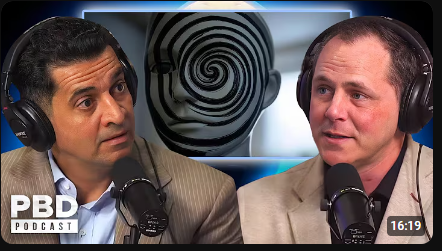Introduction
In a world where information is power, understanding the intricacies of psychological operations (PSYOPs) and human behavior is more crucial than ever. Chase Hughes, a former Navy intelligence officer and behavioral expert, has spent decades studying the art of influence, persuasion, and the darker corners of psychological manipulation. In a recent conversation on PBD, Hughes delved into the fascinating world of PSYOPs, the psychology of authority, and the subtle cues that reveal our deepest motivations. This article explores the key insights from that discussion, offering a comprehensive look at how psychological operations shape our world and how we can better understand the human mind.
The Evolution of Psychological Operations
The Origins of PSYOPs: From MK Ultra to Modern Propaganda
Psychological operations have a long and storied history, dating back to the Cold War era. One of the most infamous examples is MK Ultra, a CIA-led program aimed at developing mind control techniques. Hughes explains that MK Ultra was born out of fear—fear of American prisoners of war in Korea who, under duress, renounced their citizenship and denounced the United States. This led to a psychological arms race, with the U.S. government experimenting with hypnosis, LSD, and other methods to uncover a “truth serum.”
One of the most bizarre experiments under MK Ultra was Project Midnight Climax, where prostitutes were hired to drug unsuspecting men with LSD while scientists observed their behavior through one-way mirrors. These experiments, though shocking, laid the groundwork for modern psychological operations, which have evolved into sophisticated tools for shaping public perception and behavior.
Operation Wandering Soul: A Case Study in Psychological Warfare
One of the most successful PSYOPs in history was Operation Wandering Soul, conducted during the Vietnam War. The U.S. military exploited the Vietnamese belief that the souls of the dead must be buried in their homeland to find peace. By broadcasting ghostly voices over radio frequencies, they convinced enemy soldiers that their fallen comrades were urging them to surrender. The operation was so effective that it caused many soldiers to abandon their posts, demonstrating the power of cultural understanding in psychological warfare.
The Psychology of Influence: How Authority and Emotion Shape Behavior
The Milgram Experiment: Obedience to Authority
One of the most famous psychological experiments of all time, the Milgram Experiment, sheds light on how easily people can be influenced by authority figures. In the experiment, participants were instructed to administer increasingly severe electric shocks to another person (who was actually an actor). Despite the apparent pain and distress of the “victim,” 67% of participants continued to administer shocks up to the maximum level, simply because an authority figure told them to.
Hughes explains that this phenomenon, known as agentic shift, occurs when individuals relinquish their autonomy to an authority figure. This has profound implications for understanding how people can be manipulated into committing acts they would otherwise find abhorrent.
The Role of Emotion in Decision-Making
Hughes emphasizes that human behavior is driven more by emotion than by logic. He introduces the concept of FATE, which stands for Focus, Authority, Tribe, and Emotion. These four elements are the key drivers of human behavior, and understanding them is crucial for anyone looking to influence others.
- Focus: Novelty captures our attention. When something new or unexpected happens, our brains immediately focus on it.
- Authority: Once we are focused, we become hyper-responsive to authority figures. This is why people are more likely to follow orders from someone they perceive as an authority.
- Tribe: Humans are social creatures, and we are deeply influenced by the groups we belong to. This is why social media can be such a powerful tool for shaping behavior.
- Emotion: Ultimately, it is emotion that drives our decisions. Whether it’s fear, love, or anger, emotions are the final push that leads us to act.
The Dark Side of Human Behavior: Psychopathy and Manipulation
Identifying Psychopaths: The Role of Facial Cues
Hughes shares fascinating insights into how to identify psychopaths based on their facial expressions. One key indicator is the absence of crow’s feet—the wrinkles that form around the eyes from frequent smiling. Psychopaths, who lack genuine empathy, rarely exhibit these wrinkles. Additionally, Hughes notes that psychopaths often have a flat affect, meaning their facial expressions are less animated than those of non-psychopathic individuals.
The Role of Genetics and Environment in Psychopathy
Hughes explains that psychopathy is a complex interplay of genetics and environment. Genetics loads the gun, personality and psychology aim, and experience pulls the trigger. In other words, while some people may be genetically predisposed to psychopathy, it is their life experiences that ultimately determine whether those traits are expressed.
The Power of Visualization: Lessons from the Blue Angels
One of the most surprising insights from Hughes is the importance of visualization in achieving success. He shares a video of the Blue Angels, the U.S. Navy’s flight demonstration squadron, conducting a pre-flight briefing. In the video, the pilots meticulously visualize every maneuver they will perform, down to the smallest detail. This practice, known as chair flying, is used by elite performers in various fields, from athletes to surgeons, to mentally rehearse their actions and improve performance.
Hughes emphasizes that visualization is not just for elite performers—it is a tool that anyone can use to achieve their goals. By vividly imagining the outcomes they desire, individuals can train their brains to act in ways that align with their aspirations.
The Future of Psychological Operations: Drones, Social Media, and Beyond
The Normalization of Drones and Aerial Phenomena
Hughes discusses how the U.S. government has been gradually normalizing the presence of drones and other aerial phenomena in public consciousness. By releasing information through Freedom of Information Act requests and allowing whistleblowers to speak publicly, the government is shaping public perception and preparing society for the widespread use of drones in various capacities.
Social Media as an Artificial Tribe
Hughes warns that social media has created an artificial tribe, tricking our brains into believing that we are part of a larger community than we actually are. This can lead to a sense of disconnection and make us more susceptible to manipulation. By understanding how social media influences our behavior, we can take steps to protect ourselves from its more insidious effects.
Conclusion: Mastering the Art of Influence
In a world where psychological operations and behavioral manipulation are increasingly prevalent, understanding the principles of influence is more important than ever. Chase Hughes’ insights into the psychology of authority, the nature of psychopathy, and the power of visualization offer valuable tools for navigating this complex landscape. By mastering these principles, we can not only protect ourselves from manipulation but also harness the power of influence to achieve our goals and shape a better future.
Key Takeaways
- Psychological operations have evolved from crude experiments like MK Ultra to sophisticated tools for shaping public perception.
- Authority, emotion, and social influence are the key drivers of human behavior.
- Psychopathy is a complex interplay of genetics and environment, and can often be identified through subtle facial cues.
- Visualization is a powerful tool for achieving success, used by elite performers across various fields.
- Social media has created an artificial tribe, making us more susceptible to manipulation.
By understanding these principles, we can better navigate the complexities of human behavior and influence in the modern world.
In other words, we are all screwed…

